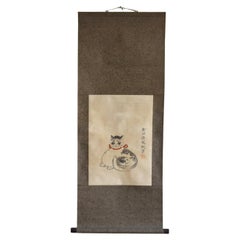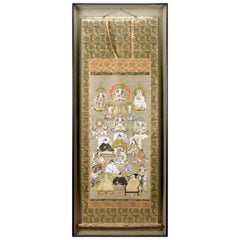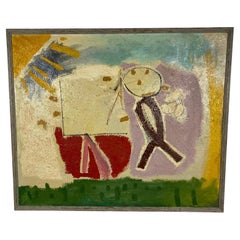Paintings
Late 19th Century Japanese Edo Antique Paintings
Paper
Early 19th Century Japanese Edo Antique Paintings
Silk, Wood
1960s American Folk Art Vintage Paintings
Canvas, Paint
1890s American Folk Art Antique Paintings
Wood
17th Century Japanese Edo Antique Paintings
Wood, Paper
Late 20th Century Haitian Folk Art Paintings
Acrylic, Canvas
1970s Ethiopian Folk Art Vintage Paintings
Canvas
19th Century Folk Art Antique Paintings
Paint, Paper
Mid-19th Century American Folk Art Antique Paintings
Glass, Softwood, Paint
19th Century Japanese Edo Antique Paintings
Brass
Mid-20th Century Haitian Folk Art Paintings
Paint
Mid-17th Century Japanese Edo Antique Paintings
Silk, Wood, Paper
1980s American Folk Art Vintage Paintings
Canvas, Wood, Paint
Early 19th Century German Folk Art Antique Paintings
Glass
Early 20th Century American Folk Art Paintings
Wood, Paint
Mid-19th Century American Folk Art Antique Paintings
Paper
Late 19th Century American Folk Art Antique Paintings
Paint, Paper
1920s American Folk Art Vintage Paintings
Paper
1970s Ethiopian Folk Art Vintage Paintings
Canvas
Early 2000s American Folk Art Paintings
Acrylic, Wood, Paint, Canvas
Mid-19th Century American Folk Art Antique Paintings
Wood, Paint
1970s Ethiopian Folk Art Vintage Paintings
Canvas
19th Century Japanese Edo Antique Paintings
Brass, Gold Leaf
2010s American Folk Art Paintings
Paint
1970s Ethiopian Folk Art Vintage Paintings
Canvas
Late 19th Century American Folk Art Antique Paintings
Canvas, Paint
20th Century Haitian Folk Art Paintings
Mahogany, Canvas, Acrylic
Late 19th Century American Folk Art Antique Paintings
Paint, Paper
1990s American Folk Art Paintings
Canvas, Paint
20th Century Caribbean Folk Art Paintings
Paint
Early 19th Century Japanese Edo Antique Paintings
Silk
Early 19th Century Japanese Edo Antique Paintings
Gold Leaf
Early 20th Century Folk Art Paintings
Paint
Mid-20th Century Mexican Folk Art Paintings
Paint
1950s German Folk Art Vintage Paintings
Hardwood, Fruitwood, Paint
Late 20th Century Colombian Folk Art Paintings
Glass, Wood, Paper
20th Century American Folk Art Paintings
Paint
1970s Ethiopian Folk Art Vintage Paintings
Canvas
1670s Japanese Edo Antique Paintings
Gold Leaf
Late 19th Century American Folk Art Antique Paintings
Other
1970s Ethiopian Folk Art Vintage Paintings
Canvas
Mid-20th Century Haitian Folk Art Paintings
Cane, Acrylic, Wood
1850s Japanese Edo Antique Paintings
Wood, Paper
20th Century American Folk Art Paintings
Paper
Mid-19th Century Japanese Edo Antique Paintings
Gold Leaf
19th Century Mexican Folk Art Antique Paintings
Tin
Early 2000s American Folk Art Paintings
Canvas, Paint
Early 20th Century American Folk Art Paintings
Wood, Paint
1880s American Folk Art Antique Paintings
Paint, Paper
1930s American Folk Art Vintage Paintings
Paint
Late 19th Century Japanese Edo Antique Paintings
Acrylic, Paper
Early 2000s American Folk Art Paintings
Canvas, Paint
Mid-19th Century Japanese Edo Antique Paintings
Paper
Mid-19th Century Japanese Edo Antique Paintings
Gold Leaf
Late 20th Century French Folk Art Paintings
Plywood, Paint
1980s Indonesian Folk Art Vintage Paintings
Glass, Wood
20th Century Italian Folk Art Paintings
Paper
19th Century Mexican Folk Art Antique Paintings
Tin
Antique and Vintage Paintings for Sale on 1stDibs
When paired with the perfect frame, the right antique and vintage paintings and other wall decorations can either subtly showcase your personality or steal the show altogether.
The earliest paintings were created on the walls of caves, proving even our ancient ancestors knew that striking artwork is meant to be on display. Cave paintings on an Indonesian island are reportedly older than the earliest cave art in Spain and France, and the figurative paintings back then were produced with inorganic pigments like iron oxide.
Later, the people of Ancient Greece — who learned about art from the Egyptians before them — conceived panel paintings of wax and tempera that were collected and publicly displayed. In the centuries that followed, artists would be commissioned to create large-scale wall murals and frescoed ceilings in sprawling European palaces and in the homes of the aristocracy.
Today, 1stDibs makes it easy for you to celebrate this rich history in your own home. Our collection of paintings includes Art Deco paintings, baroque art and a broad range of other categories. Search by material, period or other attributes to find the right fit — browse an array of 19th century landscape paintings in giltwood frames or abstract oil paintings and portraits made during the 1950s and ‘60s.
An understated contemporary work can complement your space’s color palette without drawing the focus away from the other pivotal design choices you’ve made over the years. Roy Lichtenstein’s Pop art, on the other hand, demands attention with its array of vibrant hues and subjects inspired by popular culture.
Whether you aim to create a gallery in your home or build a single, stunning focal point, you can find what you’re looking for in an extensive inventory of paintings on 1stDibs.





